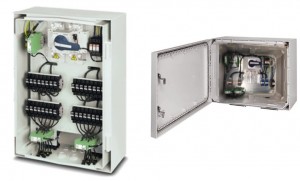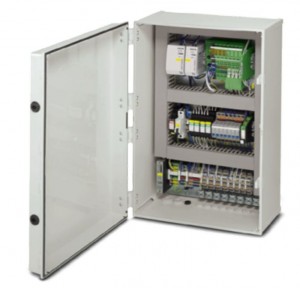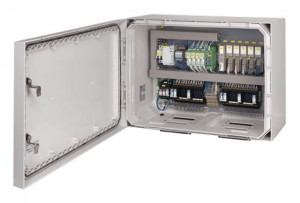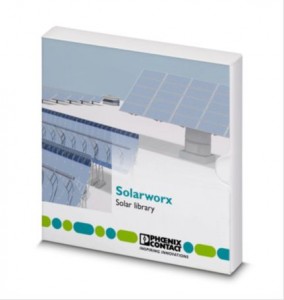Four solutions from Phoenix Contact that can help you gain competitive advantage in the photovoltaic market
1. String Combiner Boxes (SCBs)
In various regions with diverse climatic conditions, achieving maximum availability and performance for a photovoltaic system presents a major challenge for planners and installers.
The important factors here are collecting and distributing string currents, protecting the individual modules against damage from lightning and surge voltages, and also monitoring the performance of the system.
damage from lightning and surge voltages, and also monitoring the performance of the system.
Thanks to the use of optimally coordinated components and communication interfaces, the string combiner boxes can be connected to a higher-level park management system quickly and easily.
Phoenix Contact String Combiner Boxes, from 2 to 32 ways, offer:
- Optimum performance
- Fast installation and start up
- Operator satisfaction due to high availability
- Due and proper consideration of the ambient conditions
- Optimum positioning of surge protection
- Use of the best connection technologies and high quality components
- New compact SCB ( string fusing is done externally with new encapsulated string fuses – this keeps the SCB cool and reduces its size considerably!).
2. Weather Stations
A solution for the evaluation of meteorological sensors for monitoring ambient conditions in  utility-scale solar power plants.
utility-scale solar power plants.
Fully engineered, boxed solution based on an ILC 171 2TX featuring:
- all necessary I/O channels
- surge protection for data and power lines
- supply option for sensors
- sensor heating option
- Ethernet connectivity
- Standardised MODBUS-Data mapping according to SUNSPEC
- Simple parametrisation via WEB based management for adjusting sensor types and signal ranges
3. Array controllers
Each fully engineered, boxed solution is controlled by a PLC. PLC programming for all arrays can be identical. Tasks on array level:
- Aquisition and preprocessing of all relevant data for monitoring (string monitoring, local ambient parameters, inverter data …)
- Retransmission of monitored data to master PLC/IPC/SCADA in the central control room via a standardized data model (e.g. SUNSPEC/IEC 60870 …)
- Evaluation of power control commands from master PLC and corresponding control of the inverters with respect to effective and reactive power.
Individual arrays are networked to central control room via appropriate network infrastructure, e.g. fiber-optic ethernet/MODBUS TCP
4. SolarWorx solar library
The Application:
In recent years, the programming standard IEC 61131 has become established in automation  technology. This standardisation provides many advantages that can also be used for the solar industry. The Solarworx function block libraries are optimally tailored to our Inline and Axioline automation systems. For the user, this means less complex and more functions during planning and implementing solar projects. Training times and therefore costs can be kept low and system documentation becomes more transparent.
technology. This standardisation provides many advantages that can also be used for the solar industry. The Solarworx function block libraries are optimally tailored to our Inline and Axioline automation systems. For the user, this means less complex and more functions during planning and implementing solar projects. Training times and therefore costs can be kept low and system documentation becomes more transparent.
In order to keep risks during project planning and implementation as low as possible, EPCs require flexible and scalable concepts for photovoltaic systems as well as calculable software engineering options.
Customer requirements:
System integrators, however, set value on the compatibility of the individual park devices, such as string combiner boxes, inverters, energy meters and power managers. Often, system integrators are lacking the staff and know-how that they would need to implement programming for the automation of a solar park themselves. Setup and start up must be implemented quickly to enable prompt supply of the network with the generated current. Companies charged with the operation and maintenance of photovoltaic systems usually depend on fast error detection and troubleshooting.
The Solution:
The Solarworx function block libraries were created to make the creation and startup of photovoltaic projects with automation components easier and faster. This facilitates the planning and implementation of photovoltaic projects. The customer does not need to have in-depth programming knowledge as the pre-programmed blocks must only be connected with one another. Solarworx offers three different function block libraries for different tasks during the implementation of photovoltaic projects. The following figure gives an overview of the Solarworx structure. So far, there are three function block libraries: Solar Basic, Solar Advanced and Solar Add On.
Phoenix are currently working on additional function block libraries, which will be released soon.
*Editor’s Note: This post was originally published in Phoenix Contact Untied Kingdom’s Blog


